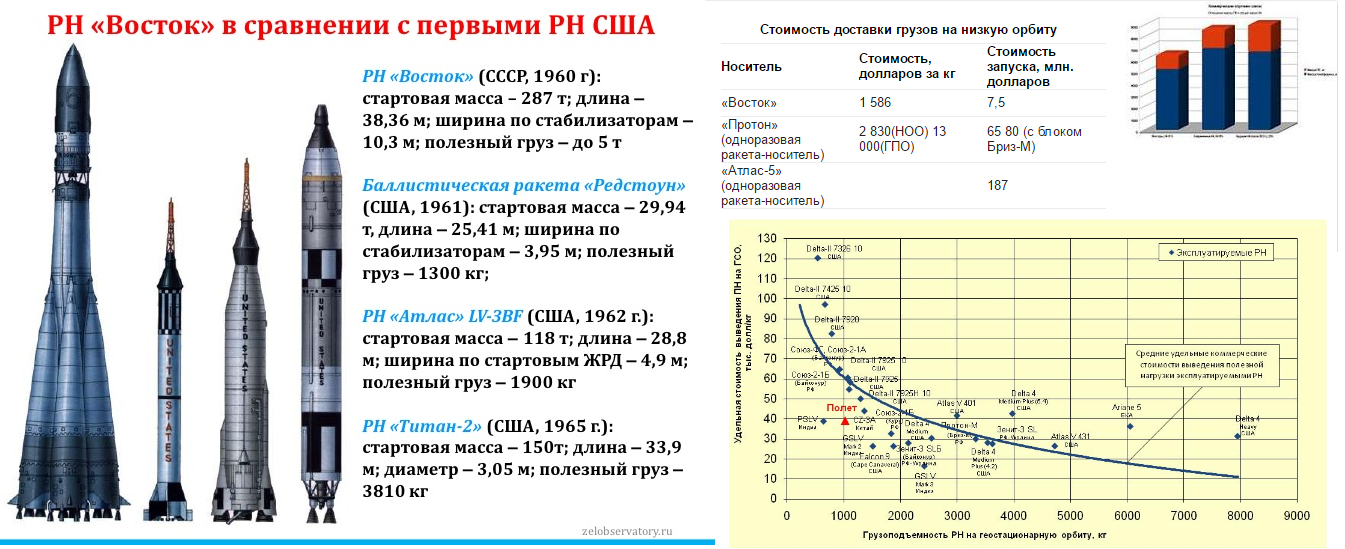Underwater launch systems: how to get out of water into orbit? Ending
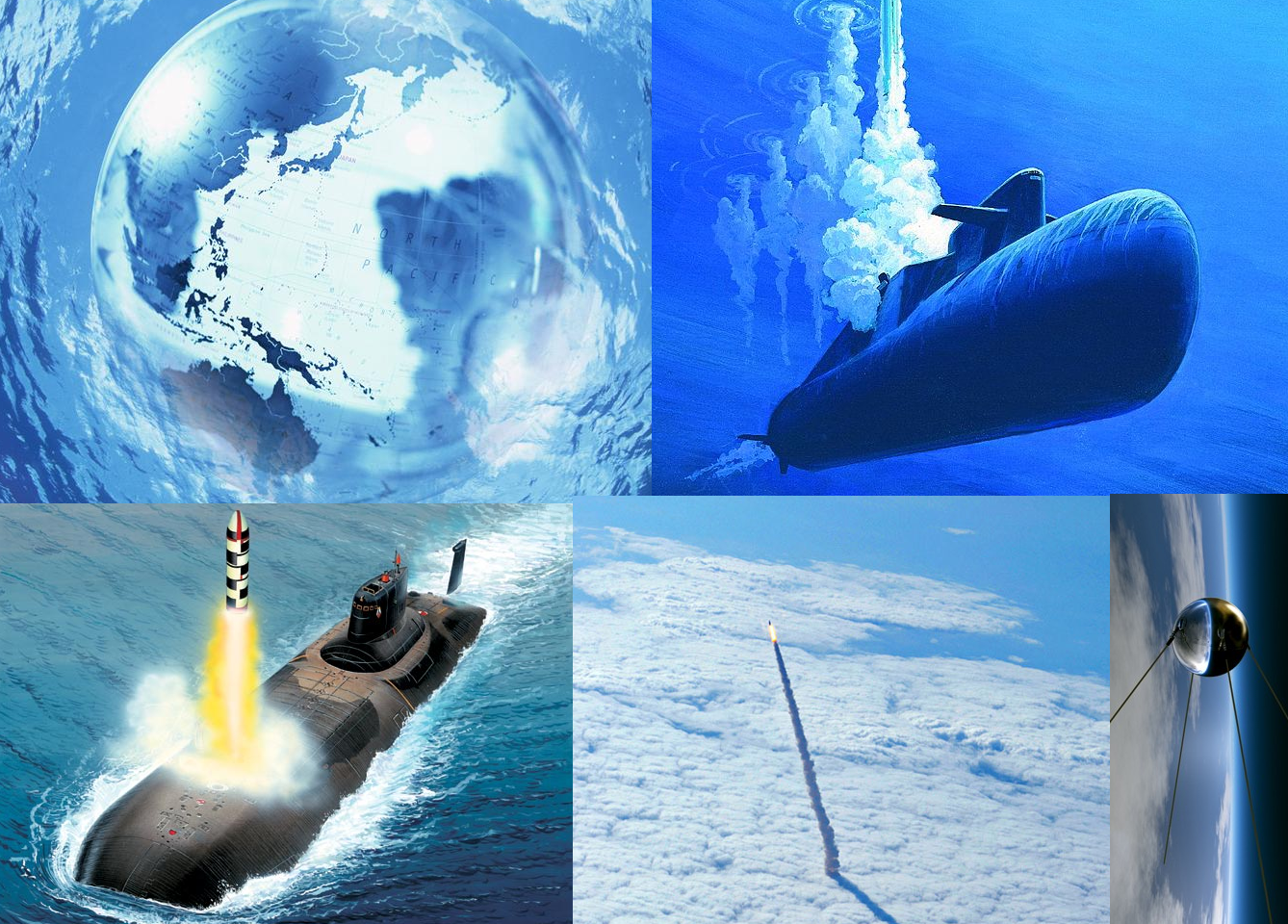
Continuation of the first part:
Underwater launch systems: how to get out of water into orbit?
')
Brief preface-explanation to the second part (who is not interested under the spoiler can not read)
1. I took into account the criticism and wishes of readers: the color was removed, formatted and brushed as I could. Do not judge strictly: as I can, it goes like that. I study and this process will be (for me) long. Be patient and do not kick.
2. About the pictures, shemes and pictures of poor quality. That is all there is. A lot of things "have sunk into oblivion", but then there was no IPhone (and there was no mobile at all) and digital cameras. PCs were exotic, the internet was fantastic. But there was tremendous secrecy, which limited the formation of the archive. Yes, that there is wise: the scanners were not traveling. "Otsinit" and "otherit" was the name of the scanning process.
Read more: Scanners in the USSR - how it all began
The documentation retention period has expired (NASA won all photos of the lunar program lost, well at least we have something left) - everything is destroyed, lost.
3. By remarks @pnetmon - I gave the answer.
- I consider his "criticism" just a niggle and explained why.
- in general, any ICBM starting from R-7 (Korolev Seven) can bring a satellite into orbit. What she did: the satellite and the astronaut, and flies so far.
The only question is the latitude of the launch and the mass of the mon.
CubeSat, the missile systems specified in the article, will also lead to the flight trajectory of the moon. R-36M2 / RS-20V Voyevoda - SS-18 mod.5-6 SATAN can really deliver a charge to Mars (the case is only in the upper stage and control / guidance system).
Example: NRO-55 Launch Atlas V in 2015
The 15 satellites in total will be deployed into a 1,000 x 1,200 km. (621 x 745) mile orbit, inclined 63.4 degrees to the equator.
The remaining two NRO satellites weighed 4 tons.
Of the 15 little things 9 NRO and 4 NASA = Cube Sat (1-4 kg);
AeroCube-5C AeroCube-7 for tracking laser systems (communications and in general);
SNaP-3 seems to provide connectivity in difficult places;
PropCube - removes impulses in the ionosphere;
Sinod-D SRI development (infrared spectrum);
etc.
Here's a platformochka, and on it a bunch of every little thing 3-4 kg each:
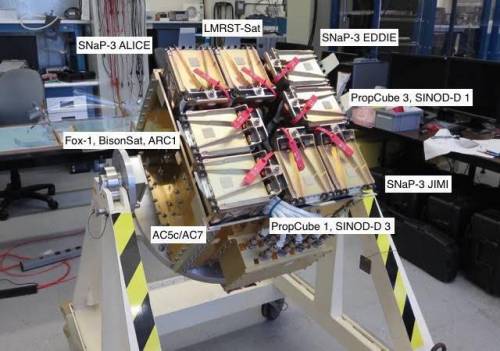
- and how, according to pnetmon , would follow the title of the article?
Underwater launch systems: how to get out of the water beyond the Karman line ?
Finishing options: “in the gap between the mesosphere and the thermosphere”, “into space”, etc.)?
If anyone has an idea, I will gladly use it.
"Into orbit" seemed acceptable to me. The End.
2. About the pictures, shemes and pictures of poor quality. That is all there is. A lot of things "have sunk into oblivion", but then there was no IPhone (and there was no mobile at all) and digital cameras. PCs were exotic, the internet was fantastic. But there was tremendous secrecy, which limited the formation of the archive. Yes, that there is wise: the scanners were not traveling. "Otsinit" and "otherit" was the name of the scanning process.
Read more: Scanners in the USSR - how it all began
The documentation retention period has expired (NASA won all photos of the lunar program lost, well at least we have something left) - everything is destroyed, lost.
3. By remarks @pnetmon - I gave the answer.
- I consider his "criticism" just a niggle and explained why.
- in general, any ICBM starting from R-7 (Korolev Seven) can bring a satellite into orbit. What she did: the satellite and the astronaut, and flies so far.
The only question is the latitude of the launch and the mass of the mon.
CubeSat, the missile systems specified in the article, will also lead to the flight trajectory of the moon. R-36M2 / RS-20V Voyevoda - SS-18 mod.5-6 SATAN can really deliver a charge to Mars (the case is only in the upper stage and control / guidance system).
Example: NRO-55 Launch Atlas V in 2015
The 15 satellites in total will be deployed into a 1,000 x 1,200 km. (621 x 745) mile orbit, inclined 63.4 degrees to the equator.
The remaining two NRO satellites weighed 4 tons.
Of the 15 little things 9 NRO and 4 NASA = Cube Sat (1-4 kg);
AeroCube-5C AeroCube-7 for tracking laser systems (communications and in general);
SNaP-3 seems to provide connectivity in difficult places;
PropCube - removes impulses in the ionosphere;
Sinod-D SRI development (infrared spectrum);
etc.
Here's a platformochka, and on it a bunch of every little thing 3-4 kg each:

- and how, according to pnetmon , would follow the title of the article?
Underwater launch systems: how to get out of the water beyond the Karman line ?
Finishing options: “in the gap between the mesosphere and the thermosphere”, “into space”, etc.)?
If anyone has an idea, I will gladly use it.
"Into orbit" seemed acceptable to me. The End.
Sea rocket and space system "Surf"
For a more complete coverage of the market of low-orbit vehicles, a study of new rocket launcher schemes was carried out. One of them was a booster rocket, created by the project "Surf".
The Surf rocket uses technologies previously developed by SLBMs: in the first stage, the RSM-52 rocket engine, the second and third stages use the RSM-54 rocket propulsion systems (the R-29RMU2 Sineva (SNV RSM-54 code, according to NATO classification - SS -N-23 Skiff)), the fourth marching stage and the fifth final stage are also based on the RSM-54 rocket technology.
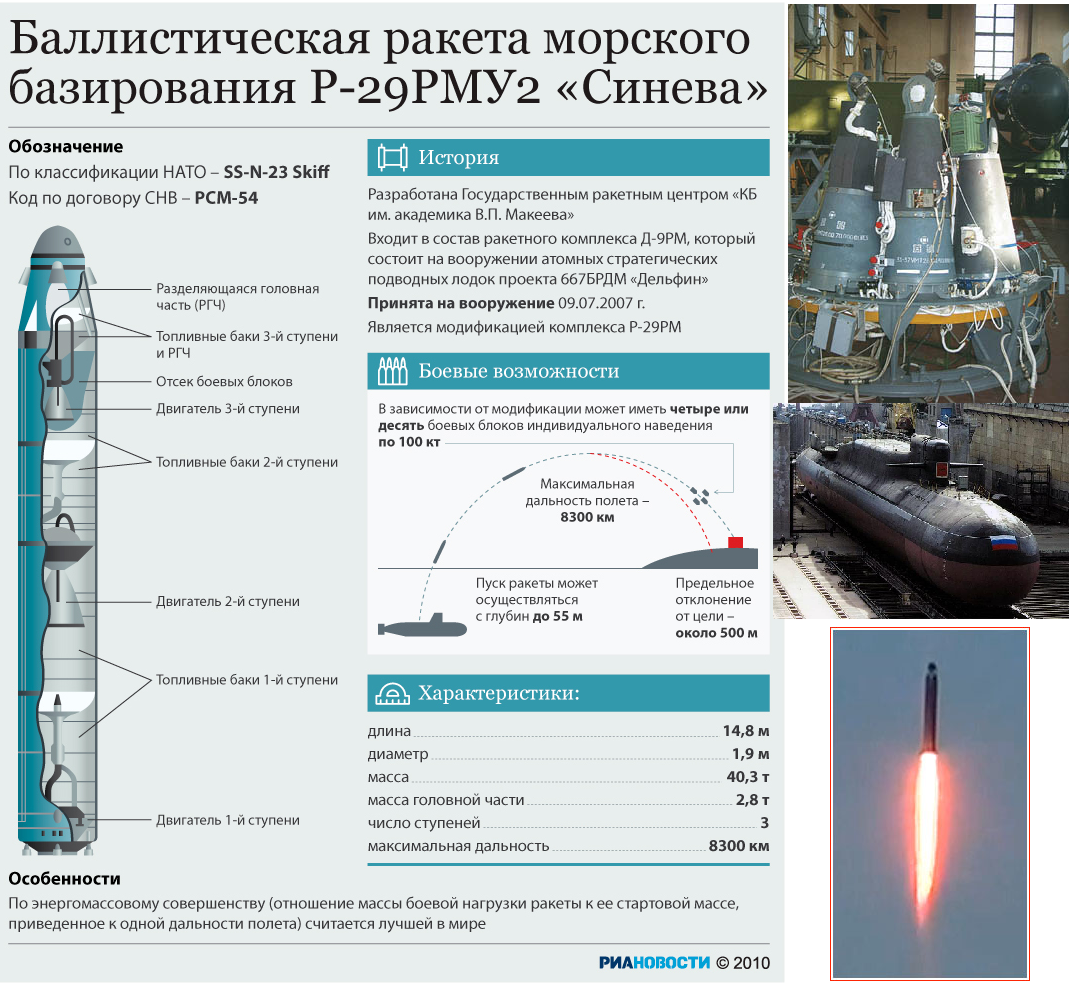
The video clip dedicated to the best in the world (in terms of energy and mass characteristics) ballistic missile RSM-54 “Sineva”. Main carrier: submarines of project 667 BDRM.
Video launch missile SLUB "Sineva" / Missile launch R-29RMU "Sineva"
The energy capabilities of the Priboy missile satisfy the upper range of low-orbit payloads. According to preliminary estimates, when launching from the equatorial areas, it displays the payload, the mass of which (in kg) depending on the height of the orbit is given in the table.

These capabilities of the Priboy launch vehicle make its development promising.
In 1993, a new impulse appeared in the works on “Surf”, which, firstly, accelerated the course of work and, secondly, supplemented the previously considered options for launching from a ground stand and a mobile craft. Such an impetus was the proposal of the American company Investors in Sea Launches, Inc. (President - Admiral Thomas H. Moorer) to develop a commercial launch vehicle launched very quickly from the sea surface to launch spacecraft of up to 2000 in space. 2500 kg. The water surface is a universal launching pad, which from many points of view provides the best parameters of launch systems. However, the practical implementation of such a start method is associated with serious technical difficulties.
The joint Russian-American commercial project was based on the “Surf” launch vehicle, in connection with which the project retained the name “Surf”. An agreement was reached on the development within three months of a conceptual engineering project for the rocket and the system as a whole. The design bureau was faced with the task of solving, in a short time, complex technical problems with the launch vehicle, its transportation to the launch site, the assembly of the rocket and its launch from the water surface. Since the rocket cannot be operated on the ground in assembled form, it was proposed to load it in parts on a ship and already on the ship to make the final assembly and testing of all systems, i.e. the ship had to be turned into an assembly workshop. As a result of preliminary studies, two types of ships were selected: the landing ship of the “Ivan Rogov” type or the container ship of the “Sevmorput” type (Fig. 2, 3).
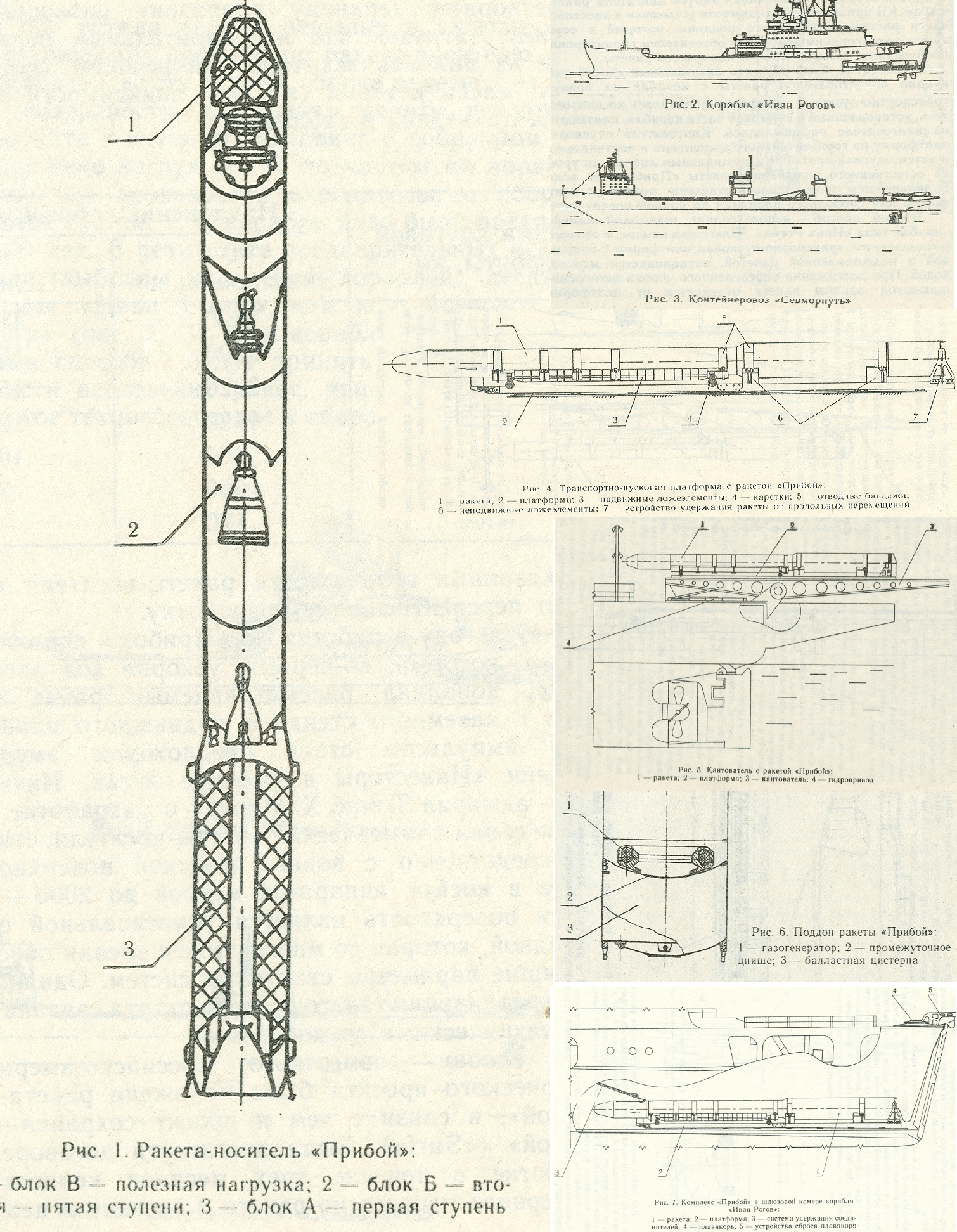
These ships with the necessary modifications will be able to take on board the components of several missiles, the equipment of the complex and the necessary technological and assembly equipment of the missiles.
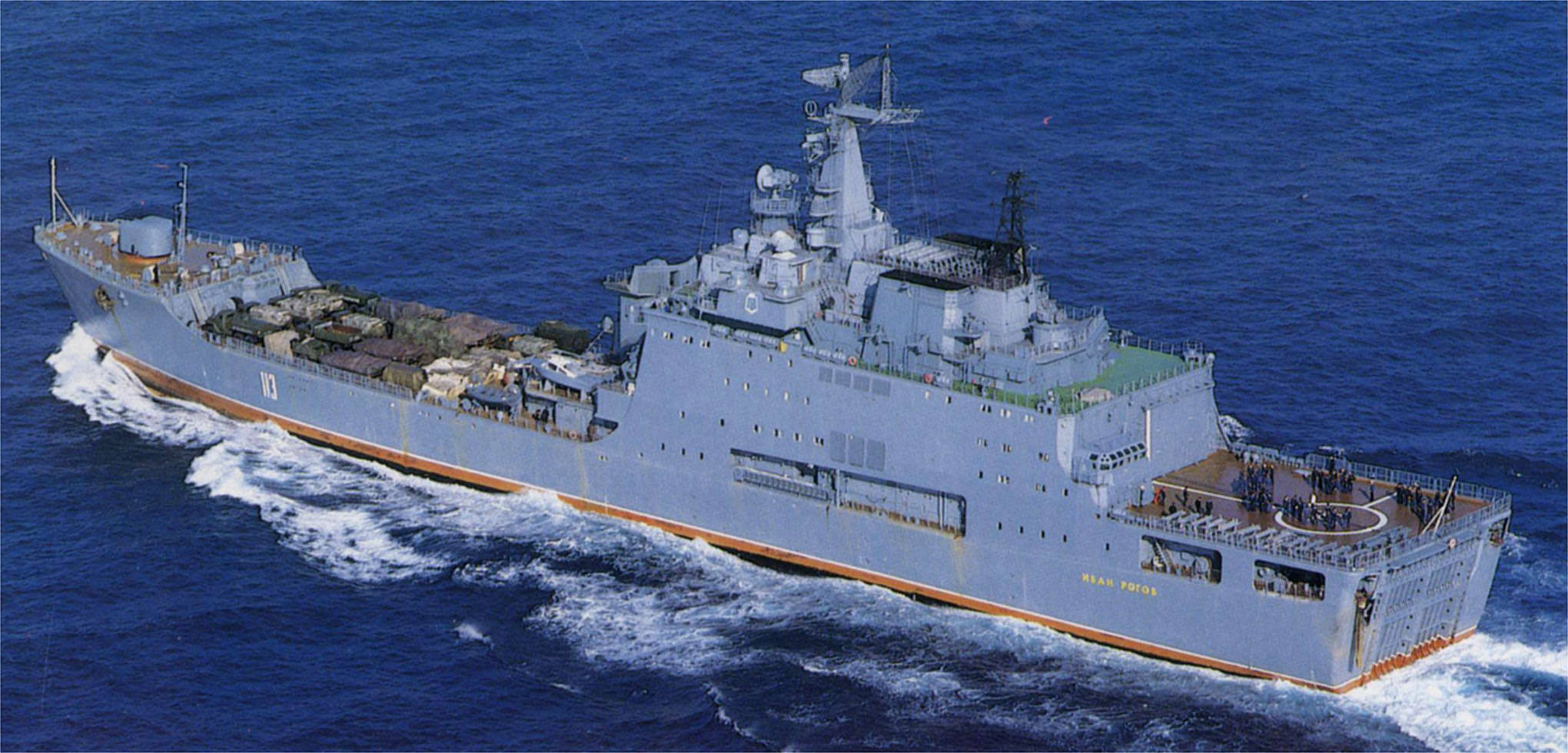
To implement the proposed technology, it was necessary to develop a unique unit - a transport and launch platform, which has special devices for loading individual parts of the rocket and then assembling them. Each of the devices, in addition to the fastening and damping elements, has three degrees of freedom, which is necessary to center the individual parts of the rocket relative to each other when assembling into uniform structures.
A general idea of the launch pad is given in fig. 4. A rocket assembled on this platform can be transported by ship to virtually any point of the oceans.

In the course of research, a large number of options for providing the necessary positive buoyancy of the rocket were considered: from pressurized elastic balloon balloons to special sliding catamaran devices. As a result, a fairly simple solution was found: since the payload in any case had to be protected with a fairing, it partially solved this problem (free air volume under the fairing). On the other hand, ensuring the launch of a rocket engine in water, the design bureau came up with the need to install a special pallet in the tail of the rocket, which, together with the front protective fairing, guaranteed the necessary positive buoyancy of the rocket.
It was necessary to choose the best way to evacuate the prepared rocket from the ship to the water surface. Of the many options for further analysis and choice left two.
The first method is for the ship “Sevmorput” (Fig. 5). The assembled rocket on the transport and launch platform was fed to the tilter installed in the aft part of the ship, the platform on the tilter was fastened. The tilter transferred the platform from a horizontal position to a vertical one and then lowered the platform with a special elevator to the level of the natural position of the Surf rocket on the water. Later, the rocket was separated from the platform for free navigation on the water surface.
The second way is to use the airlock of the ship of the “Ivan Rogov” type. The airlock, which houses the transport-launch platform with the assembled and prepared rocket, is flooded with sea water. When a certain level of flooding of the airlock chamber is reached, the rocket is separated from the platform (pops up), after which it is evacuated from the ship to the free sea surface with the help of a fusion vessel.
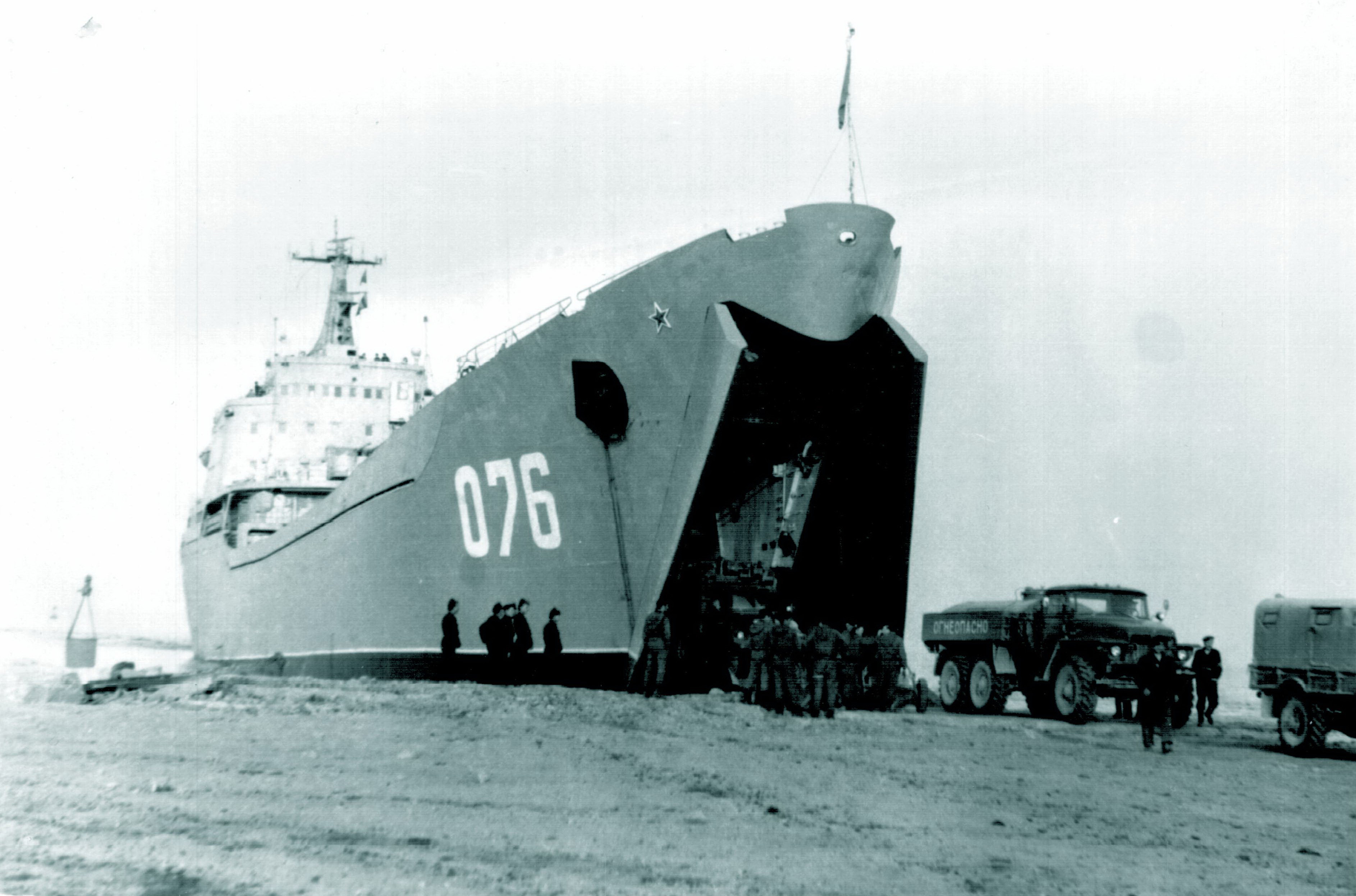
The second method was chosen as the main one.
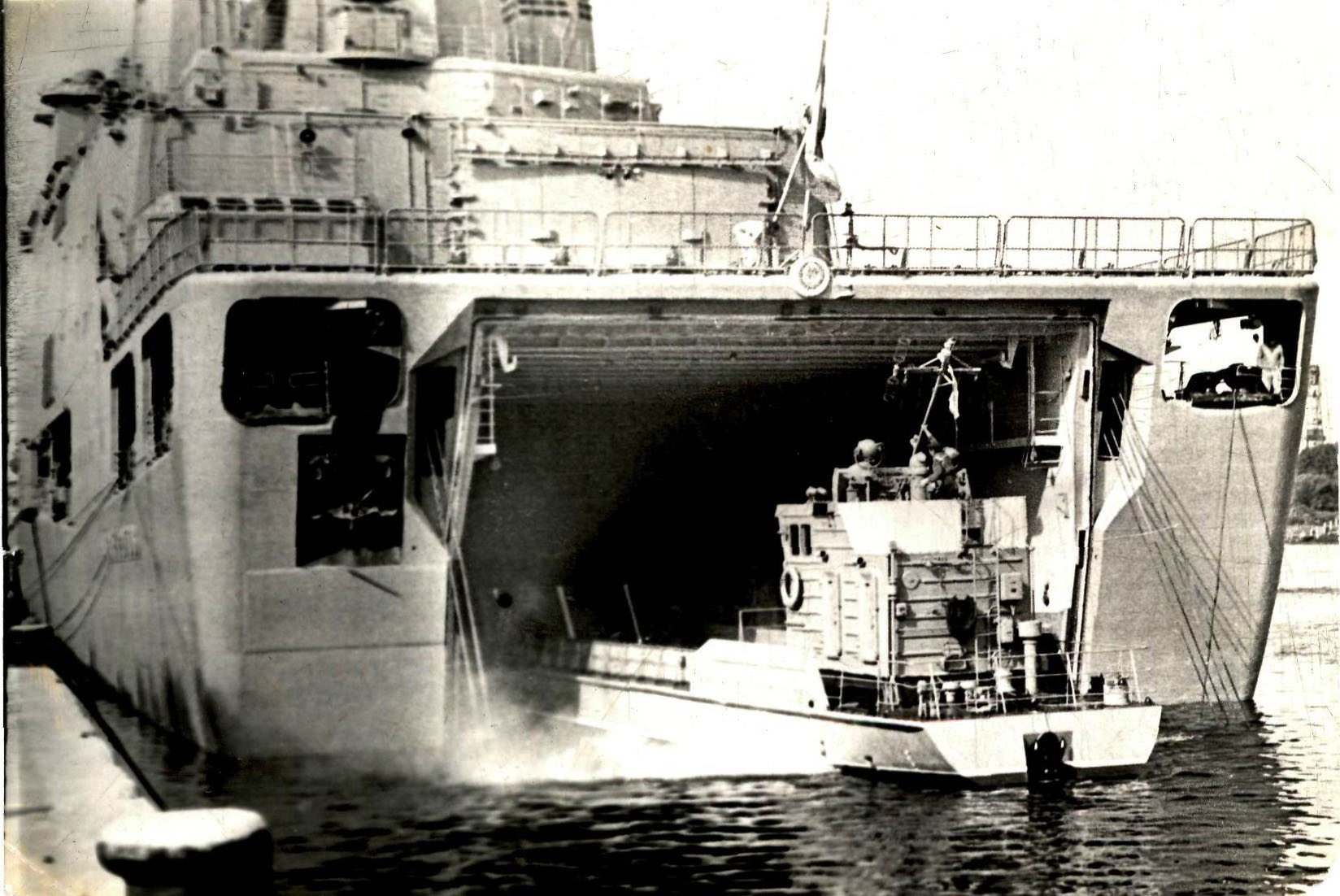
Russian and foreign experience in the development of missile systems with an underwater launch shows that the launch of the rocket’s power tool at launch is carried out in a certain air volume (or cavity). This volume was organized earlier (with prelaunch preparation) or was created directly at the start, that is, at the launch of individual elements of the propulsion system. This circumstance led to the need to install a special pallet on the stern part of the rocket (Fig. 6), which was already mentioned above. For normal horizontal navigation of a rocket and its subsequent transfer from a horizontal position to a vertical, a pallet volume of 8–15 m³ is sufficient.
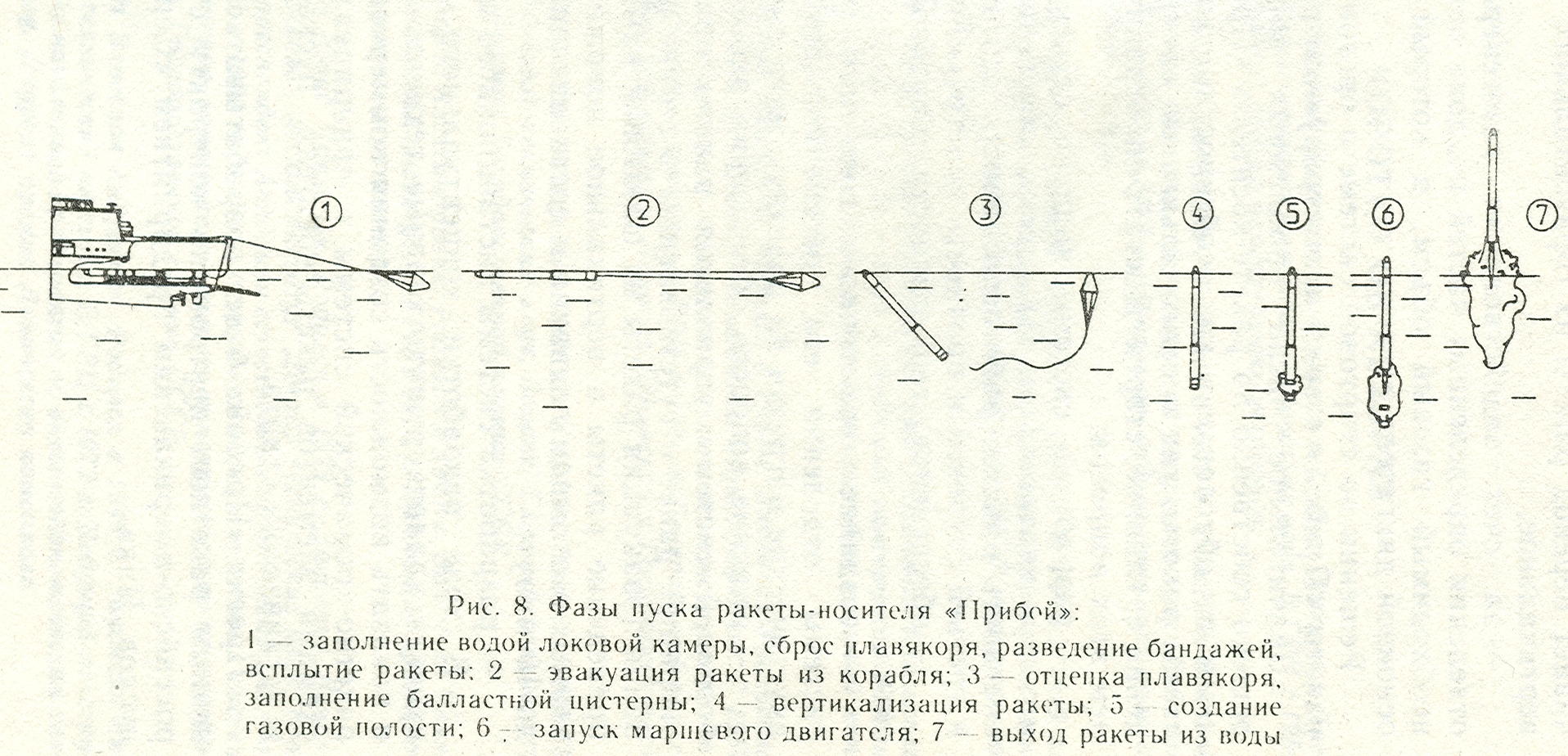
To ensure the start of the engine had to seriously complicate the pallet. As a result, it performs several functions on the Priboy rocket:
- together with the front fairing provides a horizontal rocket floating on the free water surface,
- by filling the ballast tank, the missile is transferred from a horizontal to a vertical position,
- due to the use of the gas generator after the separation of certain parts of the pallet organizes the necessary gas volume, which runs the main engine of the rocket.
Decisions on the launch system and the organization of the launch of the Surf from the water are illustrated in Fig. 7, 8.
A significant number of problematic issues were resolved by the “Priboy” launch vehicle itself. These problems are due both to the features of the rocket’s layout scheme and to the originality of the scheme for its passage and, most importantly, the launch. It is enough to limit the list of these questions:
- development of a system for pressurized rocket stages and interstage (1 and 2) compartment, ensuring rocket safety, engine performance of the second and third stages, and structural strength;
- ensuring the integrity of the onboard cable network;
- the creation of a sealed head fairing and its separation system, providing the required acoustic loads on the payload;
- addressing issues of ensuring the health of the onboard control system of the rocket during operations that were previously absent in the logic of operation (evacuation of the rocket from the airlock of the ship, bringing the rocket into an upright position) performed in autonomous navigation and components of up to 10 minutes;
- development of a rocket remote start system.
During the development of a conceptual engineering project, we managed to solve the main technical problems and show the possibility of creating a commercial maritime rocket-space system with fundamentally new schemes of launch vehicle elements, launch system and launch organization.
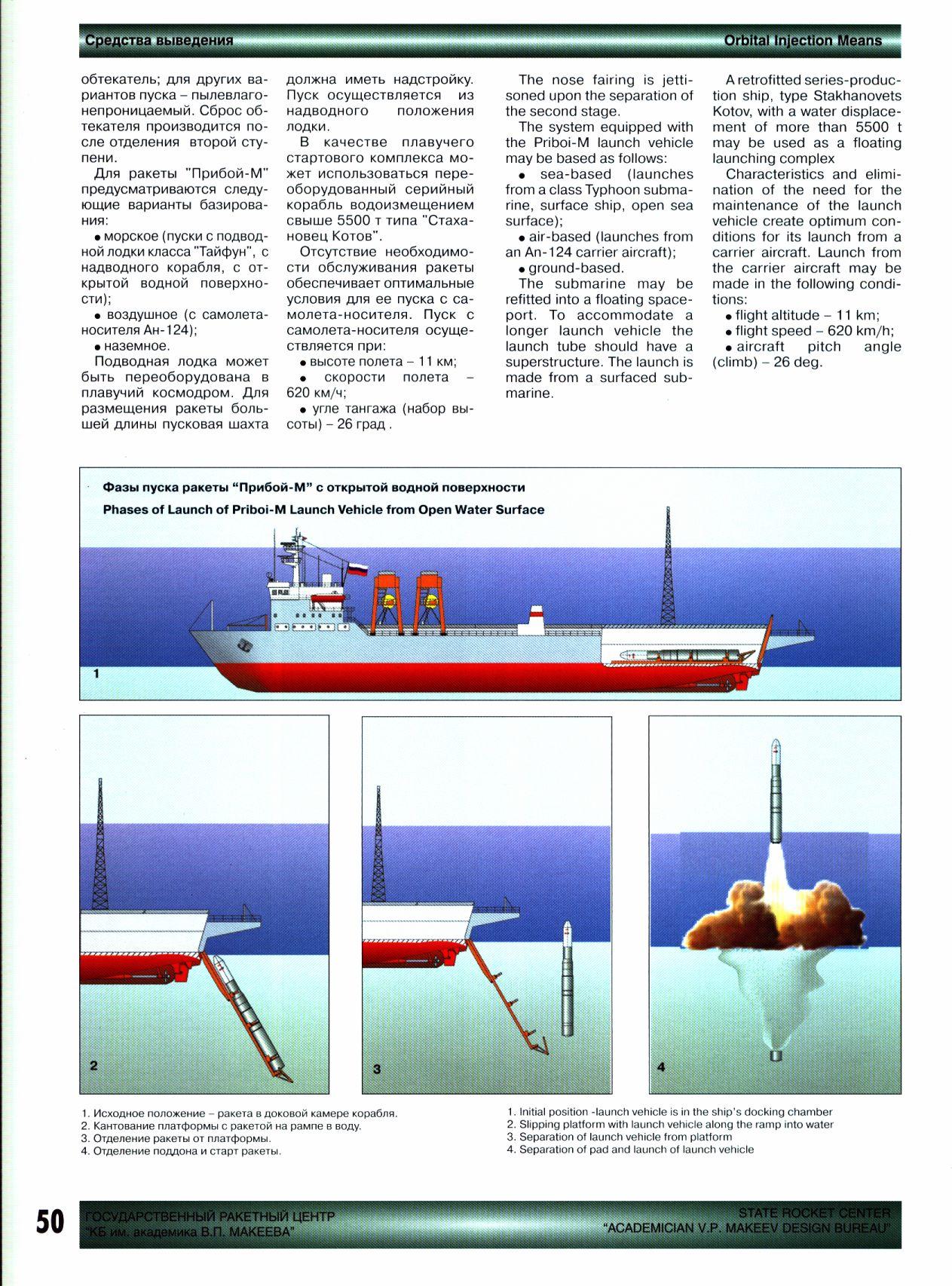
In the future, the program to create the PR Priboy had to be closed due to lack of funding.

For the same reason, the conversion to the NSC space tasks at the Nenox site, where new versions of SLBMs were previously tested, was discontinued.
Note: according to the design and development work “Priboy” a patent of the Russian Federation RU2543436 “Pseudo simulator of the launch complex” was developed and executed.
The pseudo-simulator of the launch complex, hereinafter referred to as the complex, relates to rocket technology, namely to military sea-launched launch complexes. The complex is autonomous, secretive, mobile and underwater, provides a launch to ballistic or cruise missiles capable of carrying a nuclear charge or striking elements to suppress anti-missile defense systems. The complex can serve as a beacon for targeting submarines and simulating a submarine.
The disadvantages of the prototype ("Surf") is that the ship "Ivan Rogov" is a military surface landing ship, and the possibility of finding on board of ballistic missiles assumes that its location is being monitored, and, therefore, this ship will be attacked first turn. Rocket evacuation and preparation for launch takes a long time, while the rocket will be relatively close to the ship and, most likely, when attacking the ship, it will be impossible to launch the rocket.
The essence of the invention is that the design of the complex consists of a waterproof module with a transport and launch container with a missile. The module is moved by cargo, fishing or any other, incl. submarine, hereinafter referred to as ship-transport, in the submarine and surface positions, on the deck or inside the hull of the ship-transport. At the required time, the module is separated from the ship-transport and becomes autonomous. This creates an imitation of a submarine, everything else: the launch complex, the launch of the rocket, the rocket with the head part are real. The head part can carry not only nuclear charge, a feature of the invention is the ability to carry attack elements to destroy the missile defense elements of a potential enemy to protect other warheads, for example, carrying a nuclear charge and released by other launch complexes

Figure 5 - dry cargo ship or any other, mostly non-military, vessel 20 transports modules in 21 different ways: on deck, tows for fastening assemblies 22 on the vessel’s hull or for cable 23.

On Fig - module with open (inflated) simulator of a submarine 27, deployed antennas 28, open hatch 2. The complex in the pre-launch position.
Simulator ammunition:


16 is a diagram where complexes with simulators of submarines 27 provide protection for the warhead 32 from a rocket launched by a submarine submerged from point 33, the coordinates of which are determined by the coordinates of simulators 27. The warhead 32 flies to target 34. The complexes launch missiles like that so that the head parts of the missiles fly up and paralyte 29 with parachute 30, glider 30 and balloon 31 above the respective sections 35, 36, 37 of the missile defense zone at the time of flight over these sections of the warhead 32 to protect it and counter the missile defense.
Truly:
In Russian, here at least spare parts from Mercedes give -
as they start collecting, the Kalashnikov assault rifle or tank goes anyway.
/ Bearded Soviet anecdote.
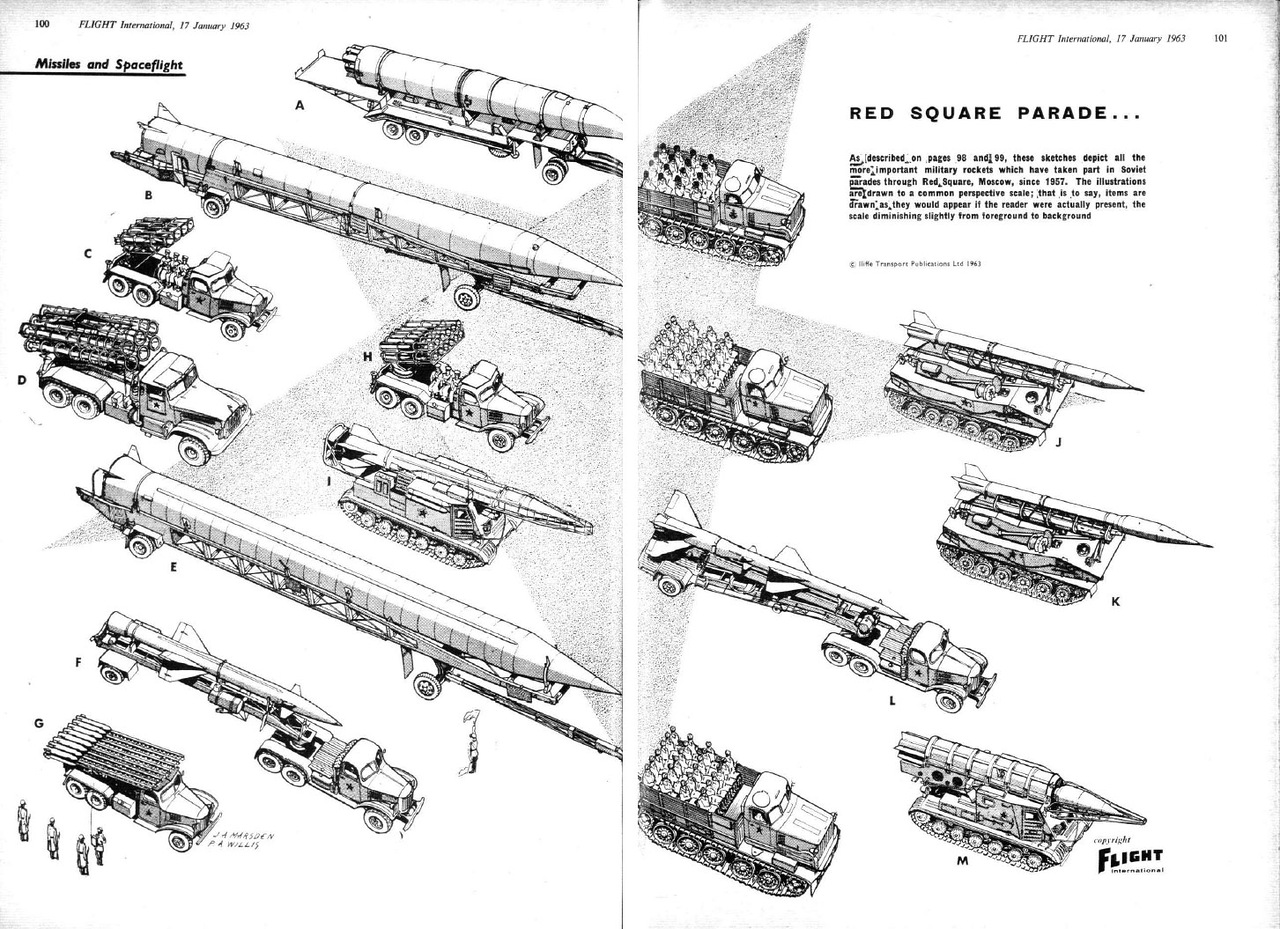
It should be noted that in the USSR a similar program was launched in August 1964 - the rocket ship designed on the basis of the ice-going ship of the project 550 “Aguema” received the working name “Scorpion” (project 909).
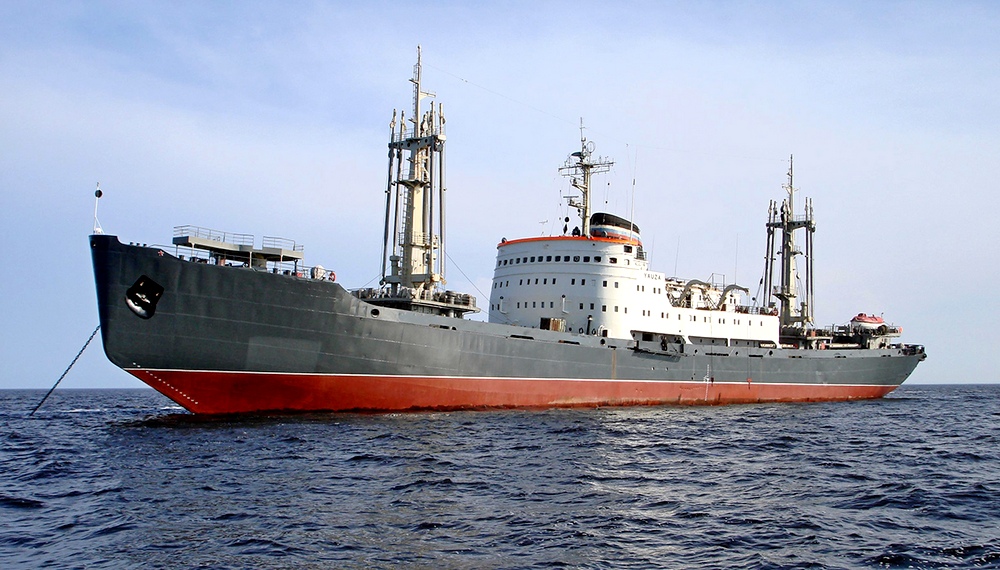
On board were supposed to be eight PU missiles R-29, and the appearance differed only by the presence of additional antennas. According to the calculations, patrolling the Arctic waters of the Soviet Union, such a vessel could hit with its missiles objects almost throughout the US territory.
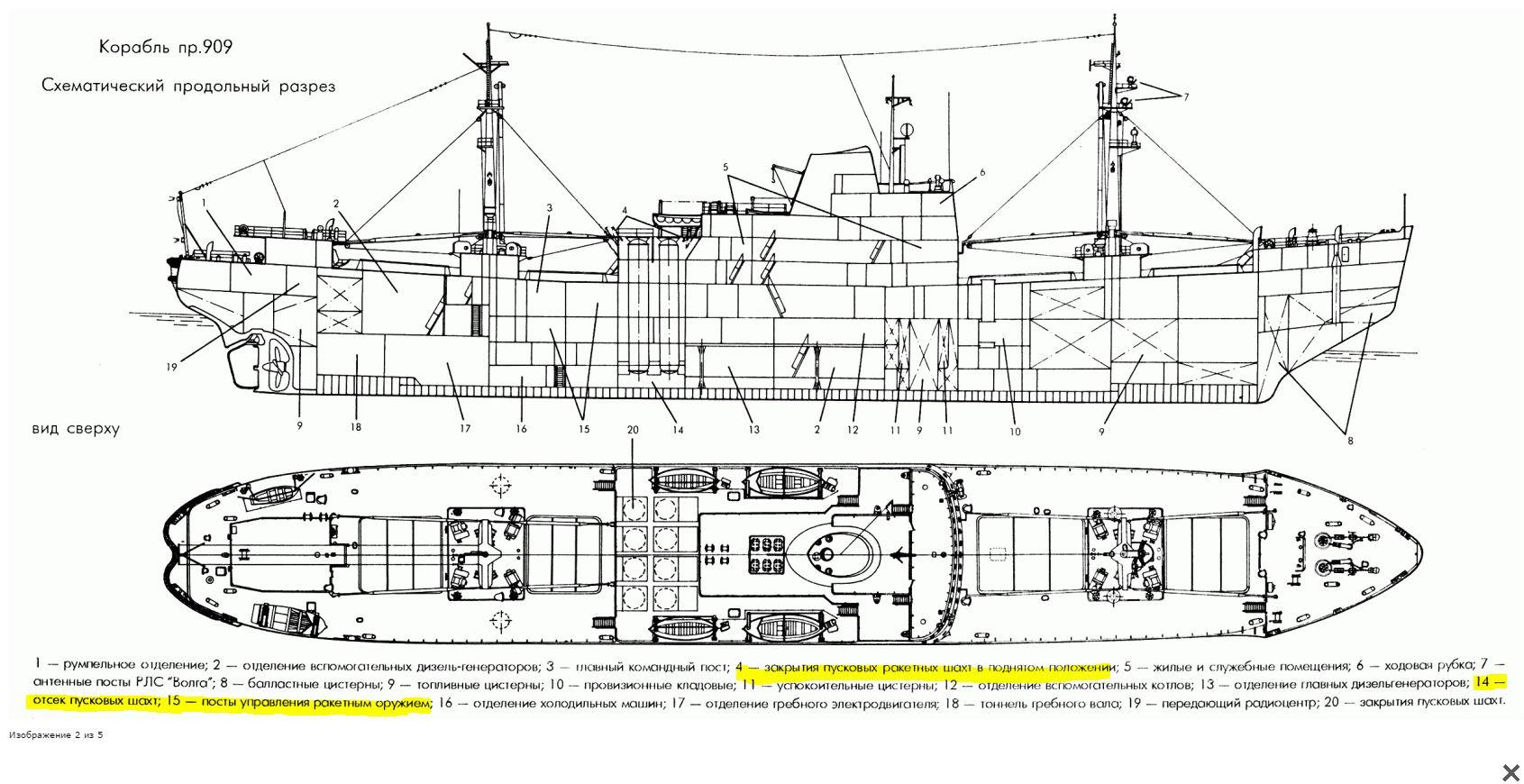
In addition, TsKB-17, already on its own initiative, also designed a rocket launcher disguised as a hydrographic vessel (project 1111, “four stakes”). The first ships in the series of these projects in 1964 prices would have cost the state budget 18.9 and 15.5 million rubles, respectively.
It's funny, but also “peace-loving” Americans already in 1963 suggested that the NATO countries create an entire flotilla of such “ships with a surprise” based on “Mariner” type transports.
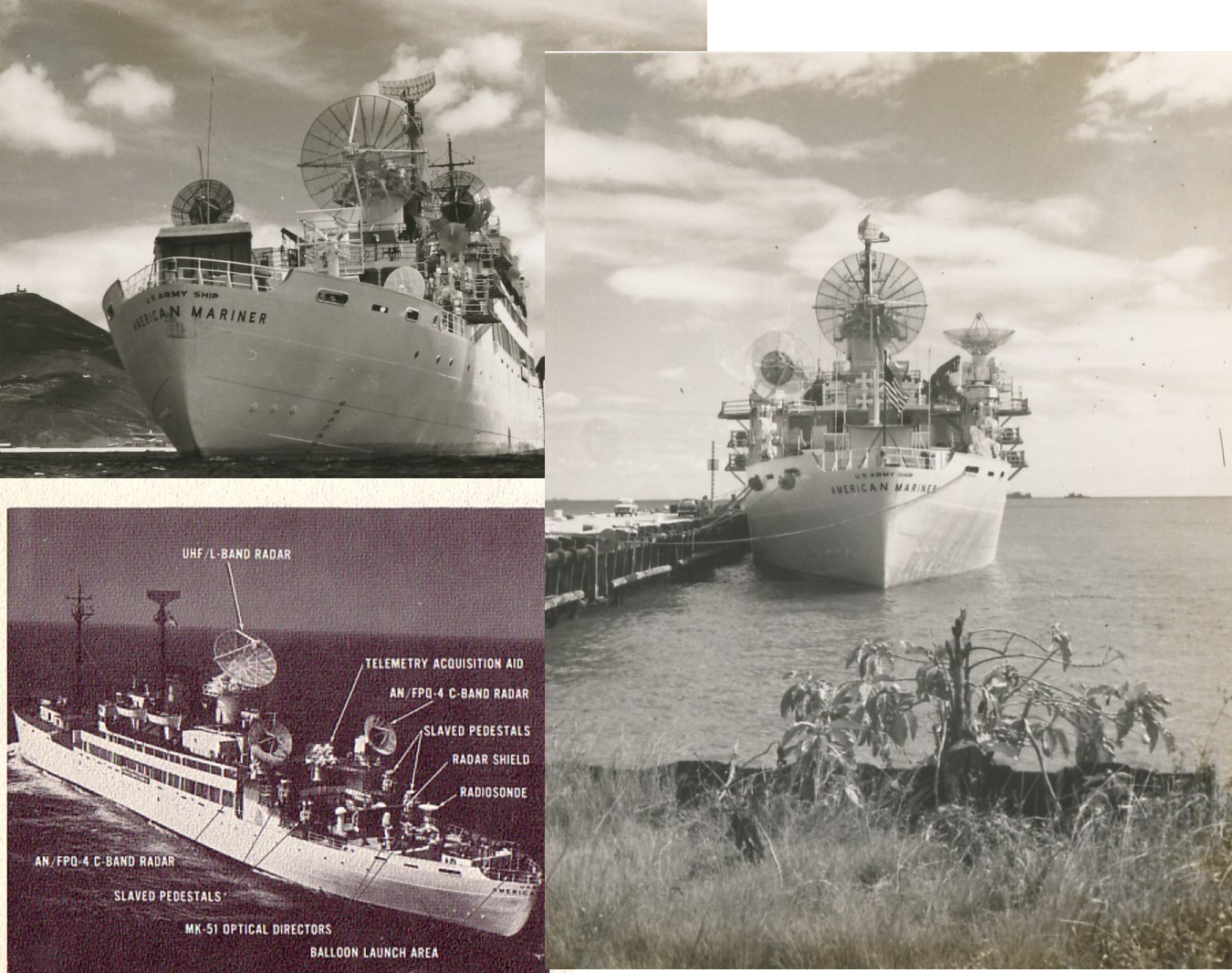
Sea rocket-space system "Rickshaw"
With the expectation of a long-term perspective, the SRC "KB them. Academician V.P. Makeeva "together with NPO Energomash, Design Bureau of General Mechanical Engineering, NPO Automation and Instrument Making and the Krasnoyarsk Machine-Building Plant State Enterprise started the development of the Riksha rocket and space complex for launching small-class spacecraft - this is the third direction of our space activity.
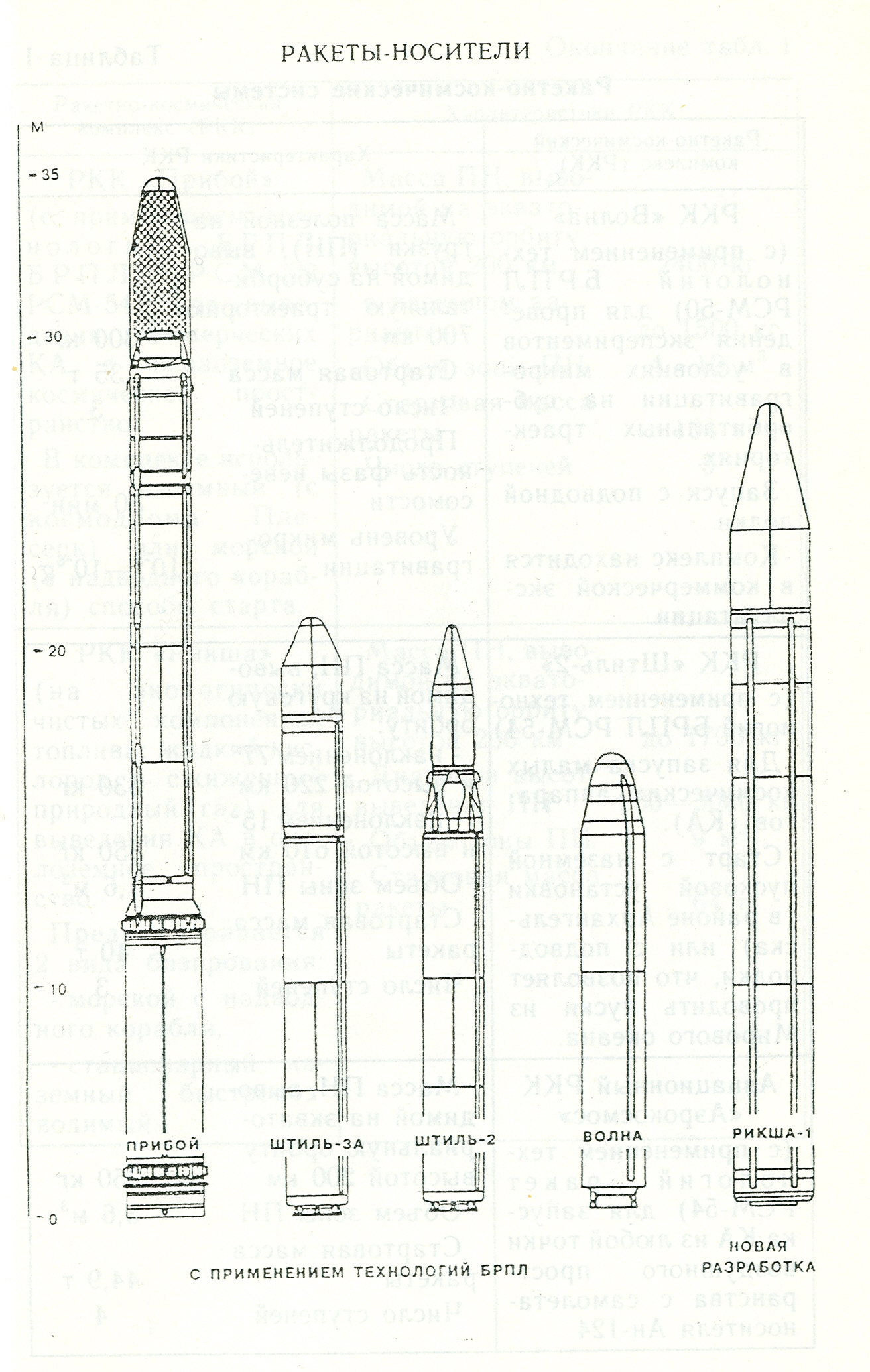
Analysis of the promising market for space services shows that small spacecraft dominate in foreign and Russian space programs, designed for low-orbit communication systems, Earth sounding, near-Earth space research, and space technology implementation. The growing interest in small spacecraft is largely due to their advantages such as low cost, speed of creation and deployment, the ability to quickly respond to the latest scientific and technological achievements and market needs.
In order to be the most fully demanded in the market of launch vehicles (10–15 launches per year), the launch vehicle must ensure the removal of communication satellites (voice transmissions) weighing about 800 kg into orbits up to 800 km, observation satellites weighing 350 - 500 kg into orbits with a height of 500–800 km, returned by satellites weighing about 1000 kg into orbits with a height of 350 km.
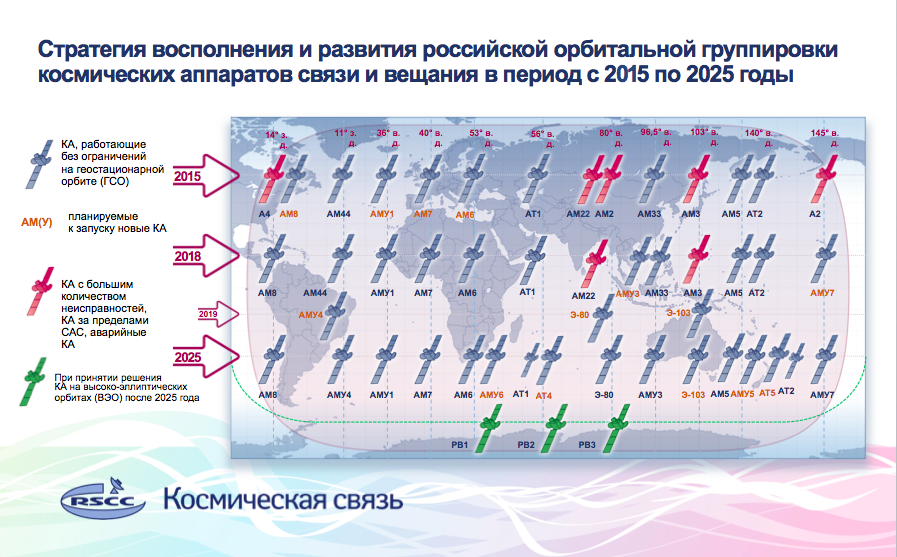

Small class spacecrafts, due to the variety of tasks, require the launching into orbits from equatorial to sun-synchronous. Covering such a wide range of orbital inclinations with stationary complexes from the territory of Russia is problematic. The task can be solved by a transportable complex based on a light-class launch vehicle. In addition, it is necessary to note the recently increased requirements for the environmental safety of rocket and space technology, the cost of its creation and operation. From this point of view, it is very promising to use liquefied natural gas paired with liquid oxygen as an oxidizing agent for launch vehicles as a fuel, which allows:
- to ensure the minimum environmental load on the environment during the fall of spent steps and in emergency situations;
- to achieve high energy and overall mass characteristics of the rocket;
- use liquefied natural gases of other countries - potential consumers, which will increase the market attractiveness of a commercial launch vehicle.
The Rickshaw complex is being developed as a means of launching to near-earth orbits and suborbital trajectories of light-duty spacecraft for various purposes from any pre-defined land and sea areas.
The main idea of the development of the complex “Rickshaw” is the maximum satisfaction of the needs of launch customers. On this basis, the complex is built in a transportable version, which allows realizing a wide range of orbital inclinations with optimal energy costs for removing payloads and using the territory of the countries-customers (at their request) for launching. For the “Rickshaw” complex, two versions of launch systems with unified subsystems are provided (Fig. 2):
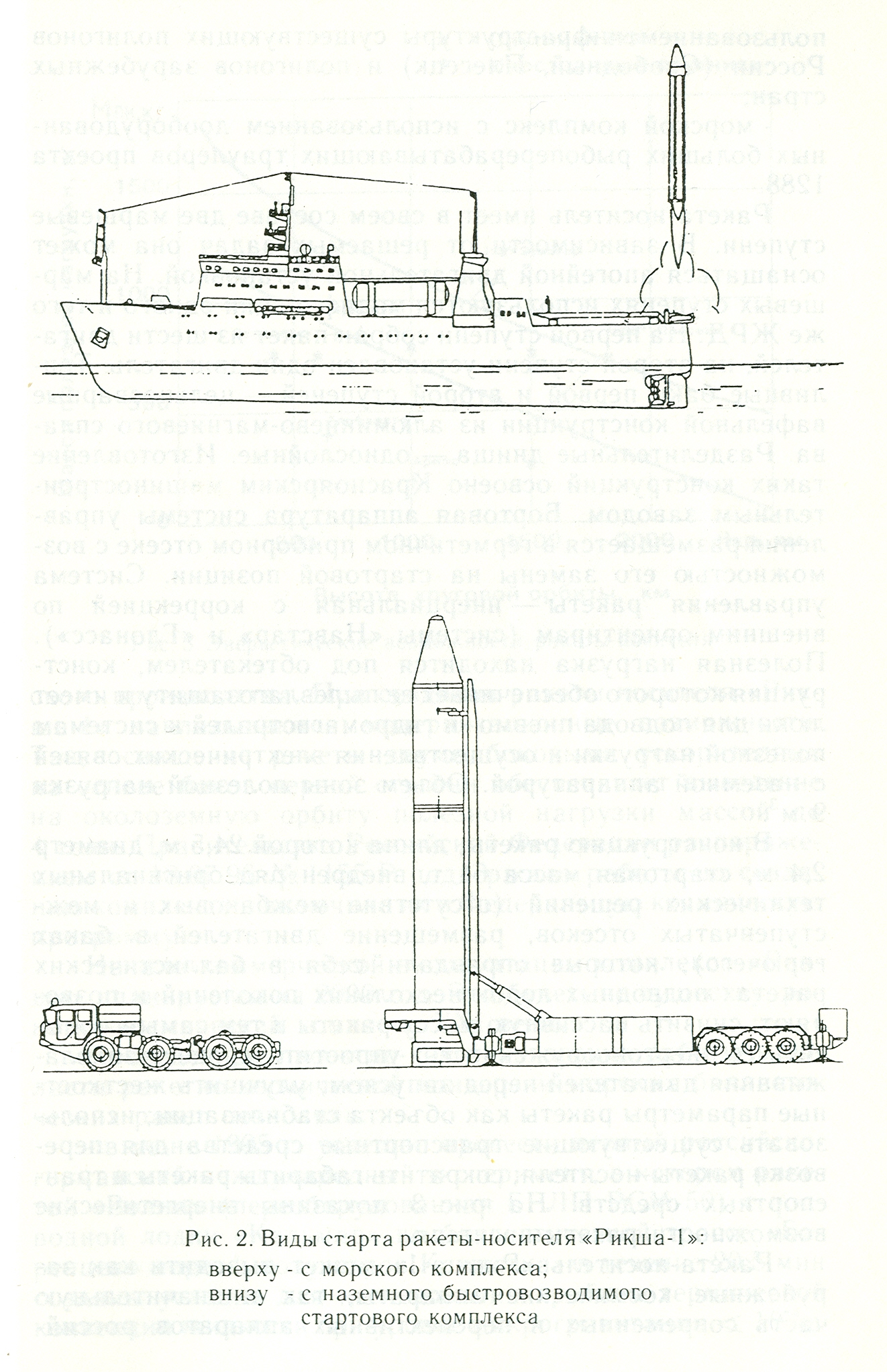
- stationary pre-fabricated launch complex with maximum factory readiness of systems and using the infrastructure of existing Russian landfills (Svobodny, Plesetsk) and landfills from foreign countries;
- marine complex with the use of retrofitted large fish trawlers of the project 1288.
The booster rocket has two marching steps. Depending on the tasks it can be equipped with an apogee propulsion system. On the march steps, modifications of the same rocket engine are used. At the first stage, a package of six engines is assembled, at the second stage one engine is installed. The fuel tanks of the first and second stages are all-welded wafer construction made of aluminum-magnesium alloy. Dividing bottoms are single-layer. The manufacture of such structures has been mastered by the Krasnoyarsk Machine-Building Plant. The onboard equipment of the control system is placed in a sealed instrument compartment with the possibility of its replacement at the starting position. The missile control system is inertial with correction by external reference points (Navstar and Glonass systems). The payload is under the fairing, the design of which provides its dust and moisture protection and has hatches for supplying pneumatic and hydraulic lines to the payload systems and making electrical connections with ground equipment. The volume of the payload zone is 9 m³.
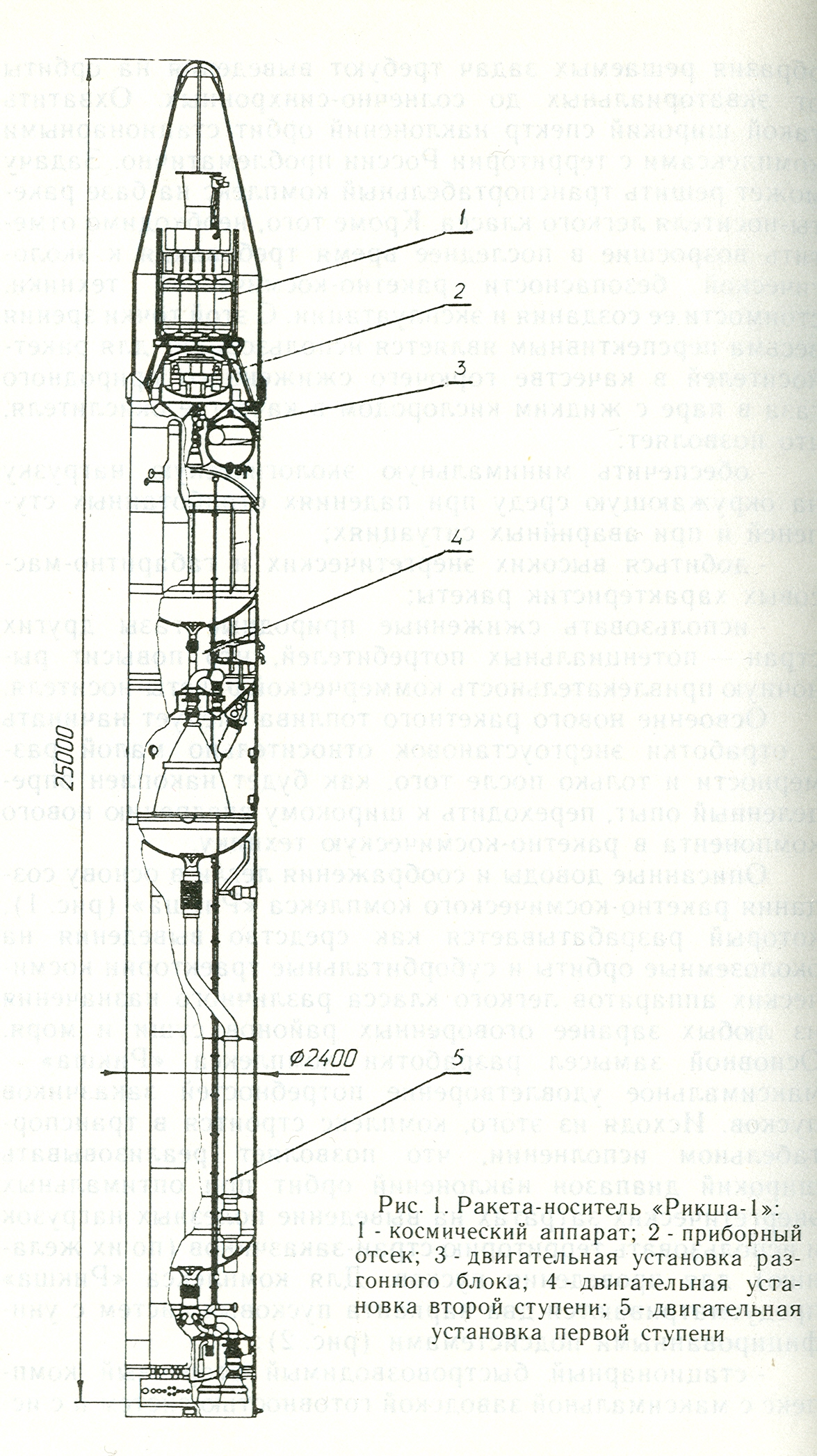
The design of the rocket, whose length is 24.5 m, diameter 2.4 m, starting weight 64 tons, introduced a number of original technical solutions (no inter-tank and interstage compartments, placement of engines in fuel tanks), which justified themselves in ballistic missiles of several submarines generations and allow: to reduce the passive mass of the rocket and thereby increase its power supply; simplify the process of engine cooling before starting; improve the stiffness parameters of the rocket as an object of stabilization; use existing vehicles to transport the launch vehicle; reduce the size of the rocket and vehicles .
In fig. 3 shows the energy capabilities of the launch vehicle.
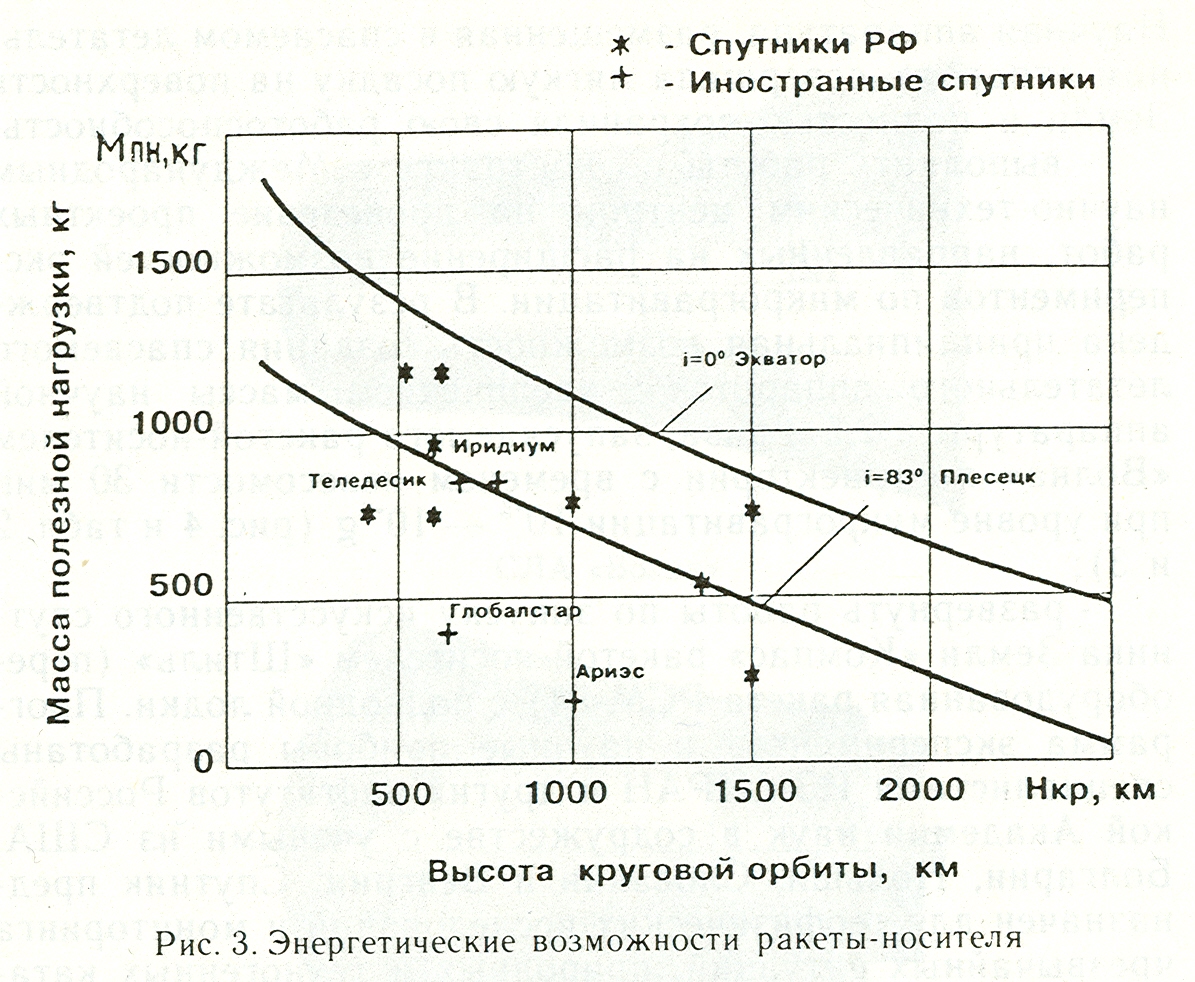
The Riksha-1 launch vehicle can output both foreign spacecrafts and a significant part of modern and advanced Russian-made vehicles. When creating the Riksha-1 launch vehicle, modernization opportunities are laid. So, equipping the rocket with two side accelerators based on first-stage tanks ensures that a payload weighing up to 4 tons is put into near-earth orbit.

Afterword:
It is a pity (from an engineering and economic point of view) that these rocket and space systems were not fully implemented.
There were three reasons for this:
1. :
« - »
, « » «» . - « » .
2. .
3. / .
— 1979 ;
— , ( US Munitions List )
- Dual-use items, the list of which is defined by the US Commercial Control List ( Commercial Control List ).
And, as is known, only the specialists of the manufacturer prepare the launch vehicle for launch.
"To give into the hands of" specialists of one of the most formidable enterprises of the military-industrial complex of the USSR high-tech, not everyone will decide on this.
4. Great competition from Russian and Ukrainian manufacturers of rocket technology.
All the above explains why the “GRTS Makeev” celebrates not only the days: the birth of the modern Russian rocketry, the machine builder, the rocket forces and artillery, the submariner and the day of the chemist, but quite deservedly on April 12th the Miass rocket planners consider their professional holiday.
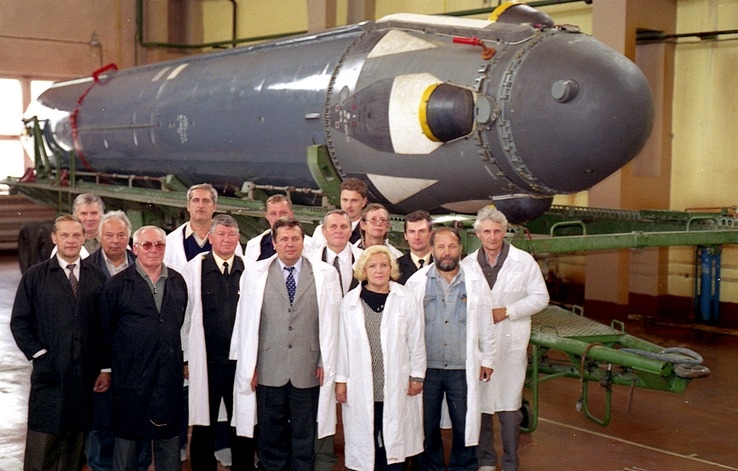

With what they heartily and congratulations.

Original sources and quotes:
[1] -- . 4. / ..
[2] 1980- . / . ., . . (1917—1993 .)
* , . :
« . .. » .. , .. , .. , .. « - »
- « . .. Makeeva
«- » © 2002
[2] 1980- . / . ., . . (1917—1993 .)
* , . :
« . .. » .. , .. , .. , .. « - »
- « . .. Makeeva
«- » © 2002
* Reconfigure technical terms and good text, no point
Photos of video, graphics and links:
www.miasskiy.ru
www.navsource.org
www.makeyev.msk.ru
www.img-fotki.yandex.ru
www.niskgd.ru
www.cableman.ru
www.habrastorage.org
www.studfiles.ru
www.ntpo.com
www.rosatomflot.ru
www.navsource.narod.ru
www.arms-expo.ru
www.fishki.net
www.makeyev.ru
www.topwar.ru
www.zonwar.ru
www.igordiksa.com
www.sovtime.ru
www.yaplakal.com
www.militaryrussia.ru
www.fas.org/nuke/guide/russia/slbm
www.directory.eoportal.org
www.miasskiy.ru
www.navsource.org
www.makeyev.msk.ru
www.img-fotki.yandex.ru
www.niskgd.ru
www.cableman.ru
www.habrastorage.org
www.studfiles.ru
www.ntpo.com
www.rosatomflot.ru
www.navsource.narod.ru
www.arms-expo.ru
www.fishki.net
www.makeyev.ru
www.topwar.ru
www.zonwar.ru
www.igordiksa.com
www.sovtime.ru
www.yaplakal.com
www.militaryrussia.ru
www.fas.org/nuke/guide/russia/slbm
www.directory.eoportal.org
Source: https://habr.com/ru/post/402127/
All Articles
